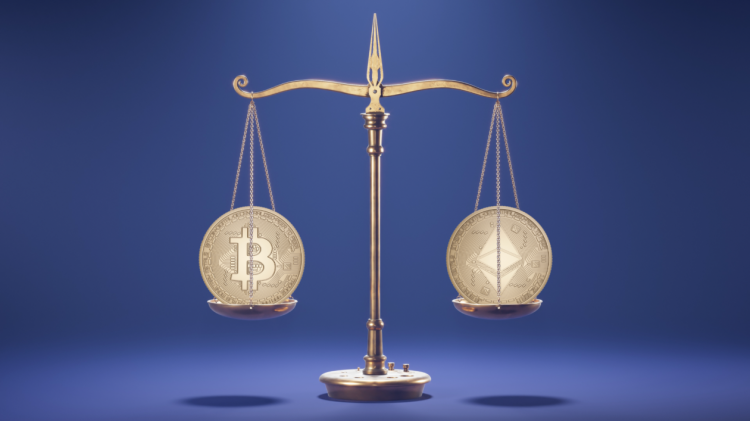What is The Flippening?
Bitcoin has topped the cryptocurrency industry in market capitalization since its first block, the Genesis Block, was mined in 2009. Ethereum joined the race in 2015 with its smart contracts to lay the foundation for decentralized finance (DeFi) and non-fungible tokens (NFT).
Some supporters argue that Bitcoin is the only truly decentralized cryptocurrency that is destined to dominate the crypto market with its limited supply. Ethereum supporters disagree and believe the smart contract pioneer is fated to overtake Bitcoin. This hypothetical event is known as “The Flippening.”
The Flippening became a popular discussion topic on social media platforms Reddit and Twitter in 2017, as Bitcoin’s crypto market dominance fell from 95.88% in March to 51.37% by August.
Ethereum’s surging price and popularity played a primary role in chopping away Bitcoin’s market dominance. On June 18, 2017, Ethereum came closest to The Flippening as Bitcoin dominance fell to 40.6% when Ethereum gobbled up 32% of the market, according to Blockchain Center data.
The case for Ethereum — digital oil
There’s a strong case to be made for The Flippening. For one, Ethereum’s smart contract ecosystem is the most popular in the crypto space and the hotbed of DeFi with over 4,000 decentralized applications (dApps) as of September 2022.
Ethereum introduced smart contract functionalities to the blockchain world in 2015. Combined with the network’s programmability, it onboarded around 3,920 developers in 2021 to the Web 3.0 ecosystem, slingshooting Ethereum as the blockchain network with the most active builders. Ethereum’s smart contract allows developers to innovate and experiment with creative use cases, such as decentralized exchanges, stablecoins, and NFTs.
At press time, Ethereum is the leading chain for all-time NFT sales with around US$30 billion, trailed by the Ethereum sidechain Ronin network with US$4 billion in sales, according to data from CryptoSlam.
Ethereum is often compared to oil, fuel or gas since it is a utility-based asset and its value is largely dictated by supply and demand mechanisms — hence “digital oil.” Much like the world’s global supply chain is fueled by crude oil, most of the DeFi space runs on Ethereum, or is associated with the network’s smart contracts.
In August 2021, Ethereum introduced a burning mechanism for its cryptocurrency Ether under EIP-1559 (Ethereum Improvement Proposal) that was included in the London hard fork. The upgrade ditched the auction-based transaction fee model in favor of a set base fee, which is later burned, or eliminated from circulation. The network has burned over 2.6 million ETH, as of September 2022.
Ethereum’s development is overseen by the Ethereum Foundation, and is led by one of the most important figures in the crypto space, Vitalik Buterin. Some critics have highlighted the structure as to why the U.S. Securities and Exchange Commission (SEC) should classify Ether as security.
Ethereum faces significant competition from rising projects known as ‘Ethereum killers’. Blockchains like Cardano, Solana, and Binance’s BNB Chain are trying to bite into Ethereum’s market share and DeFi dominance by offering faster and cheaper transactions.
Ethereum: emerging from The Merge
Ethereum’s “The Merge” is an upgrade that shifted the network to a proof-of-stake consensus protocol on September 15, with an expected 99.95% reduction in energy usage, according to Ethereum Foundation researcher Carl Beekhuizen. The Merge paves the way for scalability upgrades in the network’s ongoing Ethereum 2.0 upgrade, like sharding, which will increase the network’s capacity and transaction throughput.
The Merge replaces Ether miners with stakers, who act as validators, shifting economic incentives and reducing the selling pressure of the cryptocurrency previously fueled by miners.
Ether’s deflationary characteristic is expected to strengthen post-Merge, with more investors locking Ether to reserve a seat at the validators’ table.
But unlike Bitcoin, Ether’s total supply is unlimited.
The case for Bitcoin — digital gold
Bitcoin, being the world’s first cryptocurrency, has maintained a tight hold on the crypto market throne. The network started producing blocks in 2009, giving the Bitcoin blockchain a six-year headstart on Ethereum.
Bitcoin is secured by over 15,000 nodes and touts itself as the primary cryptocurrency of financial institutions. Investments from whales (large crypto holders) and institutions have been significant contributors to the mainstream adoption of cryptocurrencies, and so far, Bitcoin has led the way.
Bitcoin’s creator, the pseudonymous Satoshi Nakamoto, played a key role in cementing Bitcoin as the poster child of decentralization by leaving the cryptocurrency in the hands of the community. The network now operates without a single leader.
Bitcoin is often considered the safest digital store of value by investors, with its limited supply structure mimicking that of precious metals, earning it the nickname “digital gold”. Such assets are introduced into the economy through a process called mining.
Bitcoin’s proof-of-work consensus model is an energy-intensive procedure, which has sparked criticisms of the network’s likely harm to the environment.
Despite Bitcoin earning SEC Chair Gary Gensler’s stamp of commodity approval, his Commission has rejected all spot Bitcoin exchange-traded funds (ETF) to date, citing concerns about market manipulation and lack of surveillance.
Industry voices
Crypto exchange AAX head of research and strategy Ben Caselin believes there’s a slim chance for Ethereum to flip Bitcoin.
“Bitcoin and Ethereum are still highly correlated, making it unlikely for The Flippening to happen anytime soon,” he told Forkast. “Trade volume on Ether has been significant, but given the correlation and the trade volume on Bitcoin which is nearly double that of Ether, I would say chances are low.”
“If I had to make a bet, I’d say it’s 5% in the next 2 years, and 40% in the next 5 years,” Chains.com Founder and CEO Anderson Mccutcheon said, adding that a utility spike might be a potential catalyst for The Flippening.
“L1s (layer 1s), led by Ethereum, rose versus BTC over the dramatic rise in utility in 2017 due to ICOs, DeFi, NFT and gaming in 2021. Once we discover the next great utility or a more scalable application of current utilities, especially NFTs, we may see a significant spike in the L1s that will enable it,” Muccutcheon said.
Founder of Autonomy Network, James Key, believes it’s unlikely for Ethereum to overtake Bitcoin in the long run due to the high correlation of the general cryptocurrency market to Bitcoin.
“The odds of a sustained Flippening happening remains very low,” Key told Forkast. “ETH will likely experience a short pump from the attention in the weeks leading up to and during the merge if it’s successful, but it would need to 3x its market cap to flip BTC.”
Some are more optimistic.
Joshua Tobkin, CEO of SupraOracles, believes that The Flippening could happen by 2035
“I think the chances are over 70% that a smart contract platform, like Ethereum, will flip Bitcoin. But I also think it may take over 10 years for it to happen.” Tobkin told Forkast in an email response. “The main attribute that could allow a smart contract platform like Ethereum to overtake Bitcoin is programmability, which engenders more use cases outside of money or digital gold.”
Orca cofounder, Yutaro Mori, also believes that The Flippening could occur by 2030: “The odds are pretty good that Bitcoin won’t be number one by the end of this decade. Yahoo was the dominant website on the internet until the late 2000s. Now, they aren’t even in the top 10.”
Valentin Pletnev, CEO and founder of Quasar Finance, believes that Ethereum’s move towards deflationary elements may see Ether temporarily overtake BTC in 2023 or 2024.
“It’s almost inevitable that a Flippening will happen — the question rather is, will Ethereum stay number one afterward?” Pletnev told Forkast. “I would find that hard to believe, with the competition in the blockchain platform space.”
Pletnev added that Ethereum’s Achilles heel will continue to be high gas fees.
Source by forkast.news






























